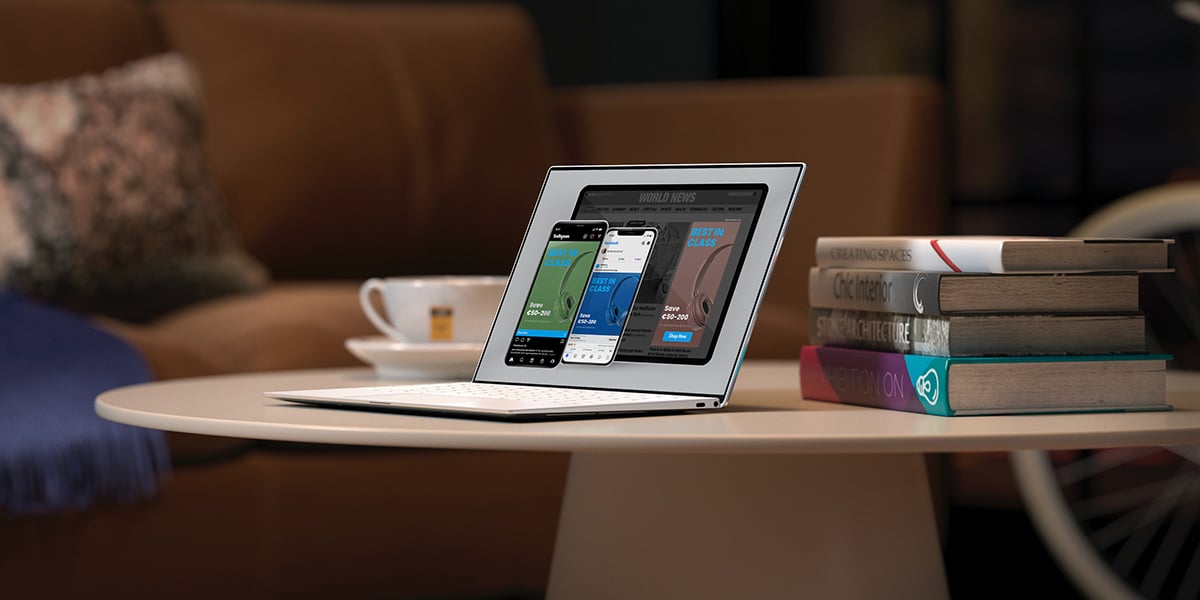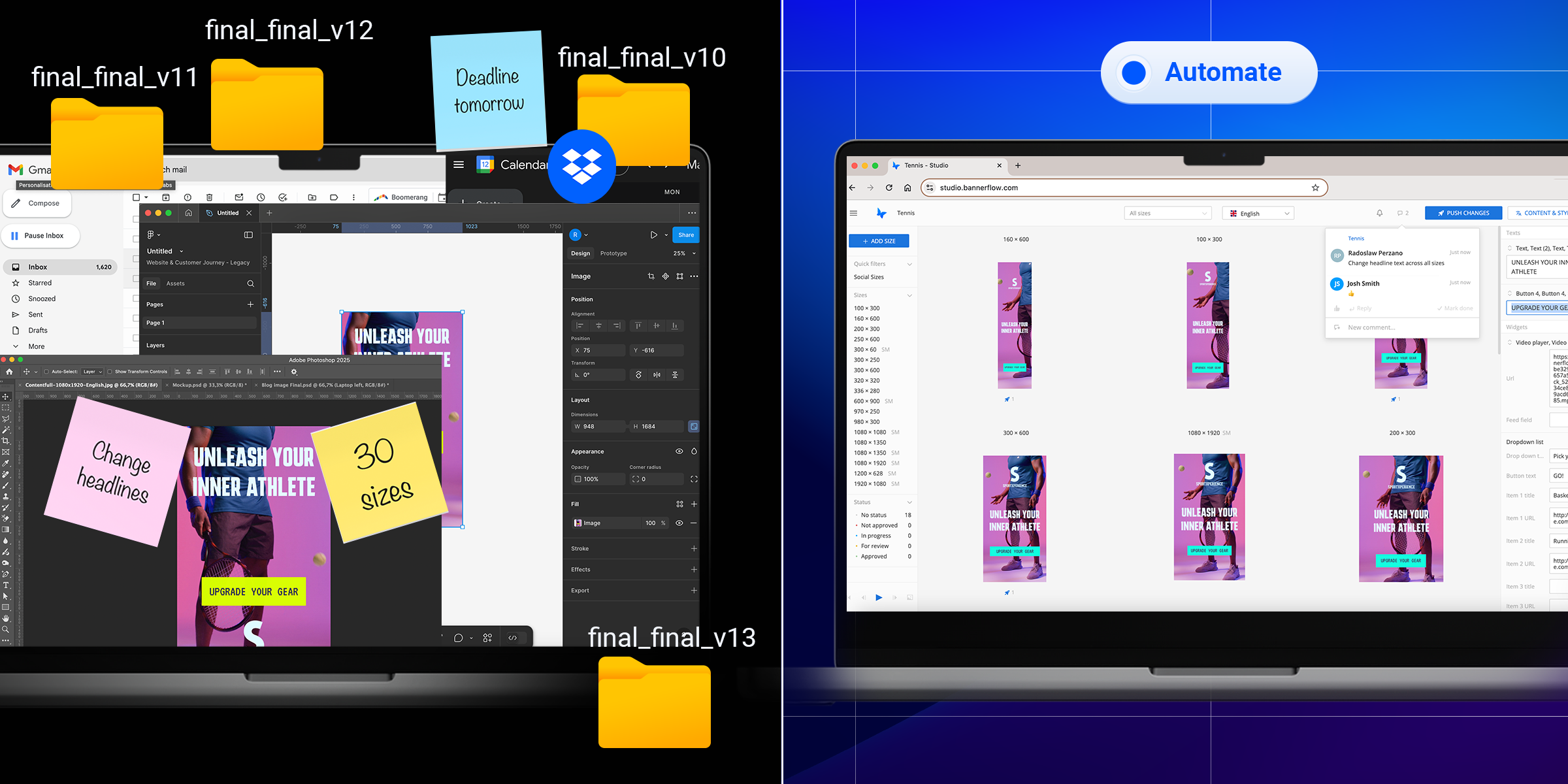One of the biggest challenges marketers face is getting people to stop scrolling and notice their banner ads. What if you could get more eyes on your ads and increase engagement by optimising their visual and audio elements?
Rich media ads are how you make your HTML5 display advertising stand out. Rich media ads elicit a stronger emotional response and generate more engagement than standard ads.
Interstitial ads are some of the HTML5 advertising’s best performers with up to 4% click-through rate. According to research by Wyzowl, 55% of video advertisers used animation in 2022. And that number looks set to grow as 67% of consumers are bored of seeing the same repetitive creative, preferring a variety of storytelling approaches that static ads can’t provide.
In this blog we’ll detail the top seven reasons why rich media needs to be part of your marketing mix. The fact is rich media helps to drive engagement and traffic more effectively than standard static banner ads. Plus, combined with HTML5, it’s helping marketers produce ever more sophisticated banners in-house.
What are HTML5 rich media banner ads?
HTML5 is the newest version of Hypertext Markup Language (HTML), the programming language used for structuring and presenting online content. HTML5 banner ads use rich media – high-quality graphics, animation, video, audio, and links – to capture the viewer’s attention.
The multimedia elements display dynamic content that encourages the viewer to interact and engage with the ad. HTML5’s responsive design ensures your banner ad will look good across any browser, OS, or device, while its small file size doesn’t slow down web page loading.
Building rich media ads is easy if you have access to a creative management platform (CMP). CMPs allow designers to produce HTML5 rich media ads without the need to code. And yes, it’s perfectly possible to code banners from scratch; but using a CMP, rich media ad production can take minutes rather than hours.
How do HTML5 ads differ from static ads
Like HTML5 ads, static ads are image-based and contain a call to action (CTA), but that’s where the similarity ends. Static ads rely on advertorial texts and still images or GIFs, but they don’t contain any additional media or moving elements.
HTML5 ads contain multimedia elements such as audio, animated graphics, and video, making them more eye-catching and interactive. They also have 3D capabilities and support dynamic content, making them more responsive.
While static ads are popular because they work across all devices and are easy to implement, they can lack creativity and user interaction. HTML5 banner ads are very interactive and can be playable. This is ideal for gaming and iGaming brands who want to entice new users to download a game or app.
Unlike standard banners which only give you two metrics – click-through rates and impressions – HTML5 banners open you up to a variety of metrics. HTML5 advertising gives more insightful and actionable data regarding engagement rates. You can explore the level of interaction for every individual element within the ad, from drop-off points within video ads to whether or not they listened to the ad’s audio.
It’s the perfect set-up for A/B testing, taking the guesswork out of optimisation. Once you know which HTML5 creatives are delivering the best results, you can know where to focus your efforts.
The benefits of using HTML5 creatives
So why are more marketers allocating their budgets to rich media html5 banner ads than ever before? A lot of their success is down to the novelty factor, but that’s not the whole story. There’s a lot more to it than that.
As the newest version of HTML, HTML5 banners offer easy multimedia integration and usability. Anyone can use it, and you don’t need any third-party plugins. Web browsers no longer support Flash and HTML5 is more efficient than previous versions. Today, Google HTML5 banners are the obvious choice for companies wanting higher performance from their display advertising.
Think LEAN and CMP
In the past, a criticism of using rich media banners has been the “weight” of the banner. This stemmed from poorly designed rich media ads (or old school Flash ads) that reduced performance; slowing down pages or obscuring content. Hence the adoption – by some viewers – of ad blockers.
However, thanks to the use of HTML5, as well as the application of the IAB’s LEAN standards, performance isn’t an issue. Moreover, if you build a rich media ad via a CMP, your ads will be lean by default.
But without further ado, here are reasons why you need to start using rich media in your online display campaigns.
1. Boost creativity
2. Drive engagement
Rich media and viewer engagement go hand-in-hand. With findings showing that brands experience higher levels of viewer engagement from rich media ads. For example, statistics from eMarketer show an improved click-through rate (CTR) using rich media banner ads. Great news for branding campaigns.
What’s more, among the many types of digital display, it’s video and rich media that are predicted to see the greatest growth during 2018 and beyond. For advertisers, they’re an effective means of engaging, and ultimately, converting.
Another area in which rich media ads can help improve viewer engagement is optimisation. Use a CMP, and marketers can watch viewer data and use functions such as heatmaps to measure the success of designs. Plus, if available, use real-time updating to revise live banners on-the-fly. Making it simple to produce more successful banners.
3. Amazing mobile ads
Mobile formats don’t need to be boring. Users are spending over four hours on their smartphones each day – it’s where you need to be seen. If you want to produce disruptive, or boring static banners, then fine – but the truth is rich media offers both the excitement and subtlety that can grab viewers.
According to Nick King, UK Commercial Director at Exponential, rich media ads are geared for mobile. They allow smart advertisers to “engage the user in a non-disruptive way that doesn’t intrude on the intensely personal relationship between the mobile device and its user.” For example, you can embrace how viewers interact with devices, using swipe actions to rotate cube banners. Better still use a CMP and scale your HTML5 rich media campaign to work across all devices.
4. Improved click-through
Compared to standard banners, rich media ads offer better click-through rates and viewability. For example, AdRoll found that rich media banner ads have a 267% higher CTR than standard static banners.
Rich media ads also provide an opportunity to cut through so-called “banner blindness” by being more memorable. When the first banner ad appeared on our screens in the mid-nineties, it enjoyed a high CTR – it was a novelty. However, now viewers are accustomed to static banner ads, becoming – effectively – blind to them.
Memorable rich media ads can better influence brand recall and recognition. Therefore, if you want your brand to be more memorable to viewers, start building HTML5 rich media campaigns!
5. Better reach through video
Different segments of audience engage better with different types of media. Some people engage best with in-banner video, others with text, and so on. Rich media allows you to effectively communicate with different segments of your audience in the format they prefer.
Video banners, and using video in-banner, is becoming more and more popular. According to eMarketer research, the most popular types of rich media ad is video. They make awesome backgrounds, can be used outstream, or as part of a HTML5 animation. The fact is using video within display advertising is increasing due to greater user engagement.
There are of course best practises to follow when using video as you want to engage with viewers, not annoy them! Yet HTML5 combined with video is easy to design, scale and publish – with the right tools. For example, a campaign for a film could have banners containing a trailer that ends with a call-to-action (CTA) frame. Simple, but in the right hands, the options are endless.
6. Dynamic creative
Being relevant to viewers is critical for a display campaign to be a success. Different viewers engage through different types of media and message. Dynamic rich media ads mean you can engage with different segments of your audience in the way they prefer, at the most appropriate time.
Dynamic creative enables you to serve rich media ads that are enhanced by data. For example, browsing behaviour, or location data. Indeed, it can be whatever data you want – or have access to. Dynamic creatives offer the ability to show ads which are more relevant – enhancing the chances of a conversion or click-through.
Furthermore, you can produce dynamically optimised rich media banners ads too. Dynamic creative optimisation (DCO) means you can produce ever more personalised display advertising. Better still you can do it in-house, all via a CMP with the right integrations.
Which leads us neatly to our last reason as to why you need to build HTML5 rich media ads…
7. You can do it in-house
Rich media is perfect for brands that work (or want to work) in-house. Indeed, HTML5 has made creating and delivering engaging rich media experiences more accessible and affordable than ever. Rich media ads produced in-house allows advertisers to embrace agile ways of working, and be on the pulse, with campaigns that are consistent across all platforms and devices.
Furthermore, thanks to the development of CMPs, the front-end skills required to develop and deliver dynamic rich media campaigns are no longer the domain of specialist agencies. Working in-house with a CMP means all marketers can produce rich media campaigns, with all the benefits of programmatic. It’s no longer the work of less than transparent agencies!
Rich media banners built through CMPs also offer the possibility to collect and analyse more useful data than standard banners. Not only do you have access to metrics such as impressions generated and click-through rate, but data on engagement, video plays, and other interactions depending on the type of ad you’ve built. It makes A/B testing, multi-variant testing, and optimisation a reality for all sizes of in-house team.
Take-away: build rich media campaigns
Today, more than ever, it is a challenge for marketers to grab the attention of consumers. HTML5 rich media banner ads are one way of making your display advertising campaigns stand-out. Building static banners isn’t going to cut it. Sorry.
Therefore, it is essential to take advantage of the latest technology. As mentioned, a creative management platforms makes building dynamic rich media campaigns a breeze – it’s what they’re designed to do after all!
Rich media is at the heart of the Bannerflow CMP. Get in contact if you want to find out more.







